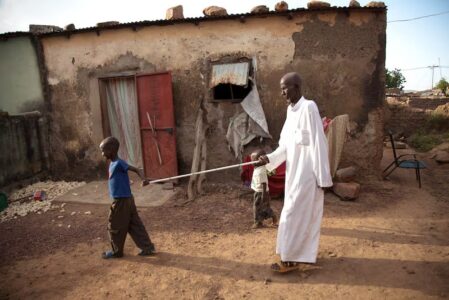One year ago, the UAE’s Cop28 presidency placed food systems at the centre of global climate action. The UAE and a broad coalition of global partners mobilised the political support of 160 heads of state and government to adapt and transform their food systems to respond to the imperative of climate change.
With climate finance now the focus of global attention at Cop29, agricultural and food systems transformation, particularly for smallholder farmers who collectively feed billions of people, stands out as one of the most urgent and effective investments that can be made.
Floods, droughts and heatwaves are devastating crop yields in many of the world’s most vulnerable countries, many of which experienced at least one month of extreme drought in 2023. Such increases in adverse climate shocks and weather are becoming persistent and severe; a dire “new normal” that threatens to push an additional 40 million Africans into extreme poverty by 2030.
The negative impacts on health and nutrition will also be high. Research shows that by 2050, rising CO2 levels will reduce the zinc content in essential crops by up to 10 per cent, iron by 5 per cent and protein by 8 per cent – nutrients crucial for child development, maternal health and the ability to fight off disease.
In this context, successful agricultural adaptation strategies will be critical to ensuring climate-vulnerable people are able to improve their lives and livelihoods in the face of deteriorating conditions.
Agricultural adaptation takes many forms around the world, but nearly all of them rely somehow on harnessing the power of innovation.
Among them are: using digital soil maps that can guide restoration of degraded lands; cultivating lesser-known local crops that thrive in harsh conditions; planting crops bred for drought and flood tolerance and high nutrition; and raising indigenous livestock breeds that have adapted to extreme heat.
Dozens of such solutions have been developed by national agricultural research centres in partnership with the global research network Consultative Group on International Agricultural Research, whose roadmap for climate-smart solutions could reach 500 million farmers by 2030, potentially reducing agricultural emissions by one gigaton annually.
But, as promising as these solutions are, they have yet to reach the vast majority of smallholder farmers, and the gulf between available climate finance and actual needs is staggering. Only 4 per cent of climate finance flows to food-related projects globally, and a mere 1 per cent addresses climate threats to smallholder farmers. Supporting agricultural adaptation in developing countries will require up to $850 billion by 2030, but the return is clear: just $16 billion a year could save 78 million people from chronic hunger.
Now, less than a year after the UAE and the Bill and Melinda Gates Foundation cemented a new partnership, we have launched two wide-reaching initiatives with the potential to benefit millions in farming communities around the world. A new AI initiative will develop open-access large language models to support farmers and agricultural extension agents with decision-making.
Built using the UAE’s open-access Falcon technology, and anchored in a close collaboration with the world’s leading international organisations focused on food and agriculture, including CGIAR, the Food and Agriculture Organisation, the World Bank and the International Fund for Agricultural Development, the “AgriLLM” will be a pioneering first effort to ensure that the power of generative AI serves the unique needs of smallholder producers in low and middle-income countries ethically and equitably.
Meanwhile, our new AIM for Scale Weather Partnership will scale access to improved weather information to farmers in low and middle-income countries, in partnership with leading development banks, technical partners and AI engineers. When it comes to investing in farmers’ access to reliable weather information, the evidence is clear that the benefits can far outweigh costs, and in some cases by as much as 100 times.

Following initial pilot activities in partnership with the Indian government during this year’s monsoon season, the AIM for Scale weather partnership will seek to expand its reach to tens of millions of farmers in India by the end of next year, and then millions more in Africa, other parts of Asia and Latin America, where half of the populations currently lack access to reliable weather forecasting.
These innovation partnerships are being developed as global public goods, ensuring equitable access to transformative technology.
But climate change is inextricably linked not only to agriculture but also to poverty and diseases that affect millions, particularly in low-income countries. Global warming is driving the spread and shift of infectious diseases into new regions, straining health systems and putting already vulnerable populations at risk. Among the growing threats are neglected tropical diseases, which impact many countries that depend heavily on local smallholder farm production.
Recognising these connections, another group of partners joined forces at Cop28 to pledge a collective $777 million towards combatting NTDs globally. This included the expansion of the Reaching the Last Mile Fund, a donor collaborative founded by President Sheikh Mohamed in partnership with the Gates Foundation, from $100 million to a landmark $500 million.
By working hand in hand with countries, the Fund seeks to eliminate two NTDs – lymphatic filariasis and river blindness – from the continent of Africa, freeing tens of millions of people from the threat of these devastating but preventable diseases.
Such progress in global health and development shows what’s possible when governments, philanthropy, the private sector and global institutions work together, and hundreds of powerful partnerships operate across the Global South. But isolated partnerships, however successful, cannot achieve the scale of change needed.
As climate change continues to devastate crops and amplify disease burden in the world’s most vulnerable regions, we need broader commitment – particularly from countries that have contributed most to this crisis. New agreements must dramatically increase funding for proven solutions without adding to developing countries’ debt burden.



